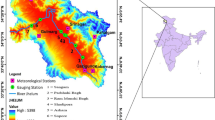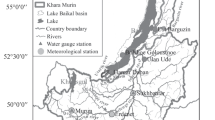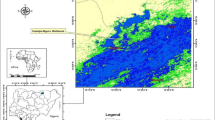Abstract
Climate change–induced changes in hydro-meteorological parameters such as precipitation, temperature, and evaporation have also altered water cycle components in various parts of the world. Severity of droughts then gradually increases with these changes. In this article, the precipitation, temperature, streamflow, and groundwater data of the stations in the Kizilirmak basin between 1970 and 2017 were studied. Precipitation (P), maximum temperature (Tmax), minimum temperature (Tmin), and mean temperature (Tmean) data that were taken from 20 meteorology stations were used. For trend analysis, linear regression (LR) and non-parametric Mann–Kendall (MK), modified Mann–Kendall (Hamed‒MK), and Spearman’s Rho (SRHO) methods were used to find out the trends in time series. Pettit test was used to determine the inception period of the trend. Although increasing trends were observed in maximum and minimum temperatures across the basin, significant trends were not observed in mean temperatures. All significant precipitation trends were in increasing direction, except for the Ilgaz station. In the change point analysis, the directional change that is occurring in maximum and minimum temperatures corresponded to the period between 1993 and 1998. On the other hand, such a period coincided to the period between 1983 and 1997. Generally decreasing trends were observed in flows, except for three stations. Majority of the present stations had increasing trends in groundwater levels. Increasing trends, on the other hand, are thought to occur due to the increase in groundwater consumptions.











Similar content being viewed by others
Data availability
Climatic data and hydrometric data provided by General Directorate of State Meteorological Affairs (DMİ) and General Directorate of State Hydraulics Works (DSİ).
Code availability
The codes were written by H.Ç. and the analysis was made by H.Ç. Licensed Matlab provided by Erciyes University.
References
Akinsanola A, Ogunjobi K (2017) Recent homogeneity analysis and long-term spatio-temporal rainfall trends in Nigeria. Theoret Appl Climatol 128(1–2):275–289
Alexandersson H (1986) A homogeneity test applied to precipitation data. J Climatol 6(6):661–675
Apak G, Ubay B (2007) First National Declaration On Climate Change In Turkey. Ankara, www.meteor.gov.tr. Accessed 31 March 2015
Atik K et al (2007) Artificial neural networks modeling of meteorological data. KSU J Sci Eng 10(1):2007
Bahadir M (2011) A statistical analysis of the flow changes of Kizilirmak River. J Turk Stud 6:1339–1356
Bayazıt M et al (2002) Trend analysis in Turkish rivers. Turk Eng News 420:4–6
Bayer Altin T, Barak B (2017) Trends and changes in tropical and summer days at the Adana Sub-Region of the Mediterranean Region, Southern Turkey. Atmos Res 196:182–199
Becker S et al (2006) Spatiotemporal analysis of precipitation trends in the Yangtze River catchment. Stoch Env Res Risk Assess 20(6):435–444
Bhend J, von Storch H (2008) Consistency of observed winter precipitation trends in northern Europe with regional climate change projections. Clim Dyn 31(1):17–28
Buishand TA et al (2013) Homogeneity of precipitation series in the Netherlands and their trends in the past century. Int J Climatol 33(4):815–833
Caloiero T et al (2018) Application of the innovative trend analysis method for the trend analysis of rainfall anomalies in southern Italy. Water Resour Manage 32(15):4971–4983
Capparelli V et al (2013) A spatiotemporal analysis of US station temperature trends over the last century. J Geophys Res Atmos 118(14):7427–7434
Ceylan A, Komuscu AU (2007) Many years and seasonal distributions of meteorological natural disasters. Clim Chang Environ 1(1):1–10
Change ICJMM, Chen Z, Marquis M, Averyt KB, Tignor M et al (2007) The physical science basis. Contribution of Working Group I to the Fourth Assessment Report of the intergovernmental Panel on Climate Change. Change, IPCC Climate 996: 2007
Change IPoC (2014) Climate change 2014: synthesis report. Contribution of Working Groups I, II and III to the fifth Assessment Report of the Intergovernmental Panel on Climate Change, pp. 151. IPCC
Chen H et al (2007) Historical temporal trends of hydro-climatic variables and runoff response to climate variability and their relevance in water resource management in the Hanjiang basin. J Hydrol 344(3–4):171–184
Cigizoglu H et al (2005) Trends in the maximum, mean, and low flows of Turkish rivers. J Hydrometeorol 6(3):280–290
Croitoru A-E, Minea I (2015) The impact of climate changes on rivers discharge in Eastern Romania. Theoret Appl Climatol 120(3):563–573
Crosbie RS et al (2010) Modelling climate-change impacts on groundwater recharge in the Murray-Darling Basin, Australia. Hydrogeol J 18(7):1639–1656
da Silva RM et al (2015) Rainfall and river flow trends using Mann-Kendall and Sen’s slope estimator statistical tests in the Cobres River basin. Nat Hazards 77(2):1205–1221
Dai ZJ et al (2010) Assessment of extreme drought and human interference on baseflow of the Yangtze River. Hydrol Process Int J 24(6):749–757
Dogan M et al (2015) Trend direction changes of Turkish temperature series in the first half of 1990s. Theor Appl Climatol 121(1):23–39
Ducré-Robitaille JF et al (2003) Comparison of techniques for detection of discontinuities in temperature series. Int J Climatol J R Meteorol Soc 23(9):1087–1101
Emadi S et al (2016) Characteristics and multifractal properties of daily streamflow in a semiarid environment. Iran J Sci Technol Trans Civ Eng 40(1):49–58
Estévez J et al (2018) Introduction to the special issue on “hydro-meteorological time series analysis and their relation to climate change.” Acta Geophys 66(3):317–318
Fallah-Ghalhari G et al (2019) Impacts of climate changes on the maximum and minimum temperature in Iran. Theor Appl Climatol 138(3–4):1539–1562
Forestry ROTMOAA (2016) The Effect Of Clımate Change On Water Resources Project Project Final Report
Franzke C (2010) Long-range dependence and climate noise characteristics of Antarctic temperature data. J Clim 23(22):6074–6081
Franzke CL (2015) Local trend disparities of European minimum and maximum temperature extremes. Geophys Res Lett 42(15):6479–6484
Ge G, Chaoying H (2001) Climate change and its impact on water resources in North China. Adv Atmos Sci 18(5):718–732
Gönençgil B, Gülten İÇEL (2010) Türkiye’nin Doğu Akdeniz kıyılarında yıllık toplam yağışlarda görülen değişimler (1975–2006). Türk Coğrafya Dergisi 55:1–12
Goyal S et al (2010) Variability analysis of groundwater levels—AGIS-based case study. J Indian Soc Remote Sens 38(2):355–364
Guner Bacanli U, Tugrul AT (2016) A climate impact of dam lake and Recep Yazicioglu Gokpinar dam lake sample. Pamukkale Univ J Eng Sci 22(3):154–159
Guo J et al (2012) Prediction of variability of precipitation in the Yangtze River Basin under the climate change conditions based on automated statistical downscaling. Stoch Environ Res Risk Assess 26(2):157–176
Hadi SJ, Tombul M (2018) Long-term spatiotemporal trend analysis of precipitation and temperature over Turkey. Meteorol Appl 25(3):445–455
Hamed KH, Rao AR (1998) A modified Mann-Kendall trend test for autocorrelated data. J Hydrol 204(1–4):182–196
Helsel DR, Hirsch RM (1992) Statistical methods in water resources (Vol. 49). Elsevier
Helsel DR, Hirsch RM (2002) Statistical methods in water resources. US Geological Survey Reston, VA
Hereher ME (2016) Recent trends of temperature and precipitation proxies in Saudi Arabia: implications for climate change. Arab J Geosci 9(11):575
Howard KEN, Griffith A (2009) Can the impacts of climate change on groundwater resources be studied without the use of transient models? Hydrol Sci J 54(4):754–764
Irannezhad M et al (2015) Interannual variations and trends in surface air temperature in Finland in relation to atmospheric circulation patterns, 1961–2011. Int J Climatol 35(10):3078–3092
Islam A et al (2012) Streamflow response to climate change in the Brahmani River Basin, India. Water Resour Manag 26(6):1409–1424
Javadinejad S et al (2019) The impact of future climate change and human activities on hydro-climatological drought, analysis and projections: using CMIP5 climate model simulations. Water Conserv Sci Eng: 1‒18
Jiang R et al (2017) Spatiotemporal variability of extreme precipitation in Shaanxi province under climate change. Theor Appl Climatol 130(3):831–845
Kadioglu M (1997) Trends in surface air temperature data over Turkey. Int J Climatol J R Meteorol Soc 17(5):511–520
Kahya E, Kalaycı S (2004) Trend analysis of streamflow in Turkey. J Hydrol 289(1–4):128–144
Kazemzadeh M, Malekian A (2018) Changeability evaluation of hydro-climate variables in Western Caspian Sea region, Iran. Environ Earth Sci 77(4):120
Kendall DG (1948) On the generalized “birth-and-death” process. Ann Math Stat 19(1):1–15
Khan MHR et al (2019) Detection of changes and trends in climatic variables in Bangladesh during 1988–2017. Heliyon 5(3):e01268
Kirshen P et al (2005) Global analysis of changes in water supply yields and costs under climate change: a case study in China. Clim Change 68(3):303–330
Kizilelma Y et al (2015) Trend analyses of temperature and precipitations in Central Anatolia. Turk Geogr Rev 64:1–10
Kundzewicz ZW, Robson AJ (2004) Change detection in hydrological records—a review of the methodology/revue méthodologique de la détection de changements dans les chroniques hydrologiques. Hydrol Sci J 49(1):7–19
Liu L et al (2012) Hydro-climatological drought analyses and projections using meteorological and hydrological drought indices: a case study in Blue River Basin, Oklahoma. Water Resour Manag 26(10):2761–2779
Lu G et al (2008) Real-time flood forecast and flood alert map over the Huaihe River Basin in China using a coupled hydro-meteorological modeling system. Sci China Ser E Technol Sci 51(7):1049–1063
Manley G (1946) Temperature trend in lancashire, 175–1945. Q J R Meteorol Soc 72(311):1–31
Mann HB (1945) Nonparametric tests against trend. Econometrica: Journal of the Econometric Society 245–259
Mishra AK, Rafiq M (2017) Analyzing snowfall variability over two locations in Kashmir, India in the context of warming climate. Dyn Atmos Oceans 79:1–9
Mishra B et al (2014) Analysis of climatic variability and snow cover in the Kaligandaki River Basin, Himalaya, Nepal. Theor Appl Climatol 116(3):681–694
Nashwan MS, Shahid S (2019) Spatial distribution of unidirectional trends in climate and weather extremes in Nile river basin. Theor Appl Climatol 137(1):1181–1199
Nikzad Tehrani E et al (2019) Trend analysis of hydro-climatic variables in the north of Iran. Theor Appl Climatol 136(1):85–97
Nyakundi RM et al (2015) Impact of rainfall variability on groundwater levels in Ruiru municipality, Kenya. Afr J Sci Technol Innov Dev 7(5):329–335
Nyenje PM, Batelaan O (2009) Estimating the effects of climate change on groundwater recharge and baseflow in the upper Ssezibwa catchment, Uganda. Hydrol Sci J 54(4):713–726
Obot NI, Chendo MAC, Udo SO, Ewona IO (2010) Evaluation of rainfall trends in Nigeria for 30 years (1978–2007). Int J Phys Sci 5(14):2217–2222
Palamalai S, Kumar KK, Maity B (2020) Testing the random walk hypothesis for leading cryptocurrencies. Borsa Istanbul Review
Pettitt AN (1979) A non-parametric approach to the change-point problem. J Roy Stat Soc Ser C (Appl Stat) 28(2):126–135
Pratoomchai W et al (2015) Sharing of people’s perceptions of past and future hydro-meteorological changes in the groundwater use area. Water Resour Manage 29(10):3807–3821
Rafiq M, Mishra A (2016) Investigating changes in Himalayan glacier in warming environment: a case study of Kolahoi glacier. Environ Earth Sci 75(23):1469
Rahaman KM et al (2016) Modeling on climate induced drought of north-western region, Bangladesh. Model Earth Syst Environ 2(1):45
Rawat PK (2012) Impacts of climate change and hydrological hazards on monsoon crop patterns in the Lesser Himalaya: a watershed based study. Int J Disaster Risk Sci 3(2):98–112
Rosenberg NJ et al (1999) Possible impacts of global warming on the hydrology of the Ogallala aquifer region. Clim Chang 42(4):677–692
Sa’adi Z et al (2019) Trends analysis of rainfall and rainfall extremes in Sarawak, Malaysia using modified Mann-Kendall test. Meteorol Atmos Phys 131(3):263–277
Salem GSA et al (2017) Impact of temperature changes on groundwater levels and irrigation costs in a groundwater-dependent agricultural region in Northwest Bangladesh. Hydrol Res Lett 11(1):85–91
Satish Kumar K, Venkata Rathnam E (2019) Analysis and prediction of groundwater level trends using four variations of Mann Kendall tests and ARIMA modelling. J Geol Soc India 94(3):281–289
Solomon S et al (2007) Technical Summary, Climate Change 2007: The Physical Science Basis. Contribution of Working Group 1 to the Fourth Assessment Report of the Intergovernmental Panel on Climate Change, Cambridge University Press, 19‒91
Steinwand A et al (2006) Water balance for Great Basin phreatophytes derived from eddy covariance, soil water, and water table measurements. J Hydrol 329(3–4):595–605
Sun J et al (2019) Analysis of spatial and temporal evolution of hydrological and meteorological elements in Nenjiang River basin, China. Theor Appl Climatol 137(1):941–961
Sutgibi S (2015) Variations and trends in temperature, precipitation and stream-flow series in the Buyuk Menderes River Basin. Marmara Geogr Rev (31):398‒414
Szwed M (2019) Variability of precipitation in Poland under climate change. Theoret Appl Climatol 135(3):1003–1015
Taylor RG et al (2013) Ground water and climate change. Nat Clim Chang 3(4):322–329
Todmal RS et al (2018) Hydro-meteorological and agricultural trends in water-scarce Karha Basin, western India: current and future scenario. Arab J Geosci 11(11):254
Trajkovic S, Kolakovic S (2009) Wind-adjusted Turc equation for estimating reference evapotranspiration at humid European locations. Hydrol Res 40(1):45–52
Turkes M (1996a) Meteorological drought in Turkey: a historical perspective, 1930–93. Drought Network News Univ Nebraska 8:17–21
Turkes M (1996b) Spatial and temporal analysis of annual rainfall variations in Turkey. Int J Climatol J R Meteorol Soc 16(9):1057–1076
Turkes M (1998) Influence of geopotential heights, cyclone frequency and southern oscillation on rainfall variations in Turkey. Int J Climatol J R Meteorol Soc 18(6):649–680
Turkes M (2003) Spatial and temporal variations in precipitation and aridity index series of Turkey. Springer, Mediterranean Climate, pp 181–213
Turkes M (2014) Drought and desertification events of climate change and its significance in Turkey 2013‒2014 (?) of drought synoptic climatological/meteorological and atmospheric connections. Hydropolitic Academy Climate Change and Drought Studies, Ankara: 1‒12
Turkes M, Erlat E (2003) Precipitation changes and variability in Turkey linked to the North Atlantic Oscillation during the period 1930–2000. Int J Climatol J R Meteorol Soc 23(14):1771–1796
Turkes M, Erlat E (2018) Variability and trends in record air temperature events of Turkey and their associations with atmospheric oscillations and anomalous circulation patterns. Int J Climatol 38(14):5182–5204
Turkes M, Tatli H (2011) Use of the spectral clustering to determine coherent precipitation regions in Turkey for the period 1929–2007. Int J Climatol 31(14):2055–2067
Turkes M et al (2007) Spatial and temporal analysis of the changes and trends in precipitation total and intensity series of Turkey. Turk J Geogr Sci 5:57–73
Van Loon A, Laaha G (2015) Hydrological drought severity explained by climate and catchment characteristics. J Hydrol 526:3–14
Von Neumann J (1941) Distribution of the ratio of the mean square successive difference to the variance. Ann Math Stat 12(4):367–395
Vu MT et al (2015) Ensemble climate projection for hydro-meteorological drought over a river basin in Central Highland, Vietnam. KSCE J Civ Eng 19(2):427–433
Wang R, Li C (2016) Spatiotemporal analysis of precipitation trends during 1961–2010 in Hubei province, central China. Theor Appl Climatol 124(1–2):385–399
Wang X et al (2014) Trend and extreme occurrence of precipitation in a mid-latitude Eurasian steppe watershed at various time scales. Hydrol Process 28(22):5547–5560
Wang X-J et al (2016) Impact of climate change on regional irrigation water demand in Baojixia irrigation district of China. Mitig Adapt Strat Glob Chang 21(2):233–247
Yenigün K, Gümüş V, Bulut H (2008, August) Trends in streamflow of the Euphrates basin, Turkey. In: Proceedings of the Institution of Civil Engineers-Water Management (Vol. 161, No. 4). Thomas Telford Ltd, pp 189–198
Zamani R et al (2017) Streamflow trend analysis by considering autocorrelation structure, long-term persistence, and Hurst coefficient in a semi-arid region of Iran. Theor Appl Climatol 129(1):33–45
Zarenistanak M et al (2015) Trends and projections of temperature, precipitation, and snow cover during snow cover-observed period over southwestern Iran. Theor Appl Climatol 122(3–4):421–440
Zeleňáková M et al (2016) Monthly trends of precipitation in gauging stations in Slovakia. Procedia Eng 162:106–111
Zhao J et al (2019) The evolvement mechanism of hydro-meteorological elements under climate change and the interaction impacts in Xin’anjiang Basin, China. Stoch Environ Res Risk Assess 33(4):1159–1173
Acknowledgements
The authors would like to thank the General Directorate of State Meteorological Affairs (DMİ) and General Directorate of State Hydraulics Works (DSİ) for providing the climate and hydrometric data.
Author information
Authors and Affiliations
Contributions
All chapters have been prepared by N.M.
Corresponding author
Ethics declarations
Ethics approval
The authors paid attention to the ethical rules in the study. There is no violation of ethics.
Consent for publication
If this study is accepted, it can be published in the Theoretical and Applied Climatology journal.
Conflicts of interest
The authors declare no competing interests.
Additional information
Publisher’s note
Springer Nature remains neutral with regard to jurisdictional claims in published maps and institutional affiliations.
Rights and permissions
About this article
Cite this article
Citakoglu, H., Minarecioglu, N. Trend analysis and change point determination for hydro-meteorological and groundwater data of Kizilirmak basin. Theor Appl Climatol 145, 1275–1292 (2021). https://doi.org/10.1007/s00704-021-03696-9
Received:
Accepted:
Published:
Issue Date:
DOI: https://doi.org/10.1007/s00704-021-03696-9




